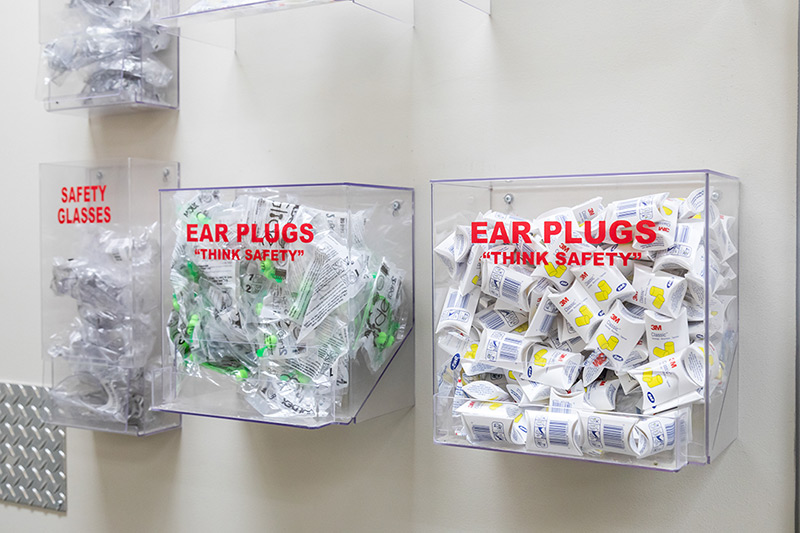Five ways the annual OSHA violations list can help protect manufacturing businesses.
Manufacturing can be dangerous work, especially if safety standards aren’t set and maintained. Serious injuries can happen when employees operate heavy machinery or complex equipment, use hazardous chemicals, or come in contact with electrical hazards, among other workplace dangers. That’s why it’s worth paying attention each October when OSHA—the Occupational Safety and Health Administration—releases its annual review of the 10 most frequent violations of the past year. Business owners in the manufacturing industry can use OSHA’s top-10 list as a tool to assess potential hazards in their own spaces so that they can be proactive about protecting the health and safety of their own employees. And, as a result, the health and bottom line of their business.
Occupational health and safety: Protect against slips, trips, and falls
Slips, trips and falls are the most common cause of workplace injuries across industries. Spills, snow and rain, stepladders, and loose mats and rugs can all cause accidents and injuries. Employee injuries can include strains and sprains, bruises, bumps, fractures, scratches, and cuts. To help prevent injuries, keep walkways, stairs, and workspaces clear of cords, wires, spills, and clutter—and keep them well lit. Test ladders prior to using and ensure the ladder is on a non-slip surface when in use.
Control hazardous energy (lockout tagout): Train and authorize employees
It’s the employer’s responsibility to protect employees from injury when they perform service and maintenance to machinery and equipment. When employees don’t follow procedure the likelihood of injuries may increase. Injuries can include electrocution, burns, amputations, fractures, and lacerations. Unauthorized workers, or those who have not been trained, should not perform service or maintenance. Make sure other employees understand the lockout procedures and the serious, real-life consequences of noncompliance.

Personal protection equipment: Outfit employees with proper safety equipment
Personal protective equipment (PPE) should be worn to prevent or minimize exposure to hazards that can cause illness and injuries. Chemical, radiological, physical, electrical, and mechanical hazard exposures can all cause injuries. Depending on the manufacturing application and need, employers should ensure their employees have access to PPE like gloves, safety glasses and shoes, coveralls and body suits, ear protection, respirators, and hard hats. Employees should also be trained to anticipate when PPE will be necessary, how to use it properly from start to finish, what its limitations are, and how to properly maintain and dispose of the items.
Machine guarding: Protect employees from flying debris and other machinery hazards
Safeguards on machines are essential to protect employees from dangerous—and preventable—injuries. Broken fingers and hands, amputations, spinal cord injuries, burns, eye injuries, and even traumatic brain injuries may occur when machine guarding standards aren’t followed. Make sure equipment has proper shielding to contain sparks, sprays, and any debris—like metal shavings and wood chips—during use. Train employees to properly use equipment and alert others in their area when they’re using it.
Material handling precautions: Train employees in proper lifting, storing, and stacking techniques
Injuries can happen to employees that aren’t necessarily OSHA violations, but are still costly for employers. When employees suffer lower back injuries, shoulder strains, and knee and ankle injuries—most often due to improper lifting techniques—that’s outside of OSHA’s standards, but still a risk to the business. Employees should be encouraged to take precautions while lifting, climbing, and the like and proper technique should be part of their training to help prevent injuries.
During the past several years, the weight of labor shortages, cybersecurity threats, and supply chain disruptions has been a heavy load to carry for everyone in the manufacturing industry. Safety requirements and trainings can be overlooked in the midst of everything else, but it’s crucial to invest time and energy into a safety plan. When a manufacturer ignores OSHA and other safety standards, they could potentially suffer the loss of employees because of injury. On top of that, violations can be costly to manufacturers who can incur significant fines. Improving the safety of the workplace for the workforce can help business owners and leadership manage the rising costs of doing business by keeping the costs associated with injury down—and that includes the rising insurance premiums that could stem from unsafe workplaces. Employees are a manufacturer’s greatest asset, and they need protection.
Most insurance companies have a loss prevention and safety services team that will help policyholders establish a safety program for their business and provide training courses and resource materials if necessary. Additionally, you should also consult your local experts to address your specific circumstances. OSHA’s lists cause concern, it’s a good time to have a conversation and implement a plan.
For more tips about OSHA compliance, Industry Today has additional information available here. For the most up-to-date regulations and interpretations of the rules, visit OSHA’s website at osha.gov.

About the Author:
Troy Tepp is a Director of Safety Services with Sentry Insurance. Sentry provides property, casualty, life insurance, and retirement products to manufacturers and businesses. Learn more at sentry.com.
Scott Ellyson, CEO of East West Manufacturing, brings decades of global manufacturing and supply chain leadership to the conversation. In this episode, he shares practical insights on scaling operations, navigating complexity, and building resilient manufacturing networks in an increasingly connected world.